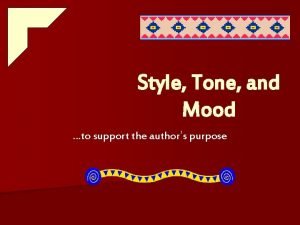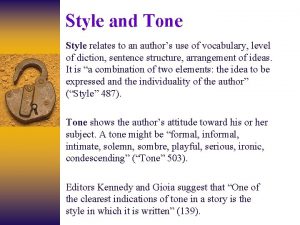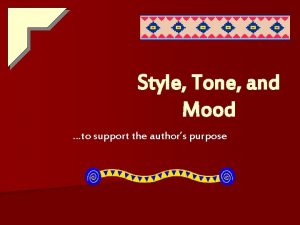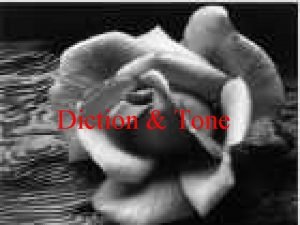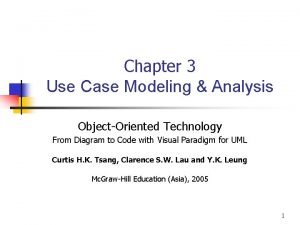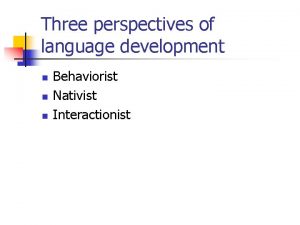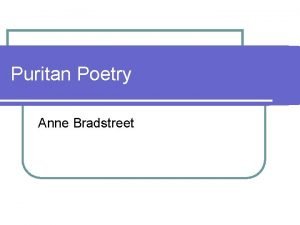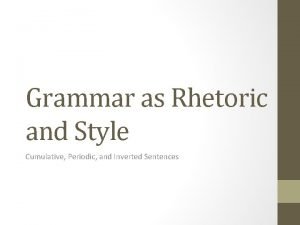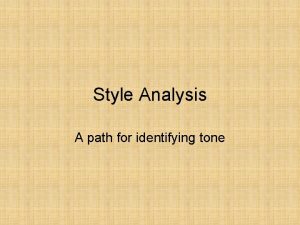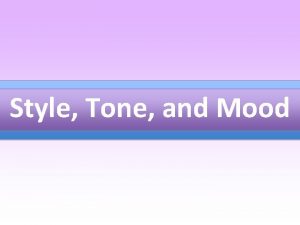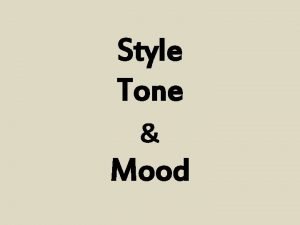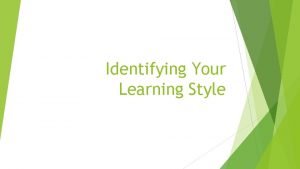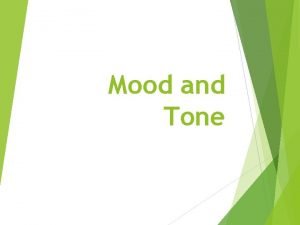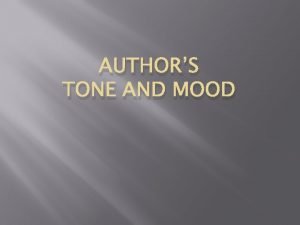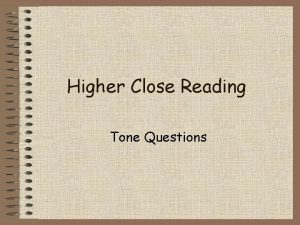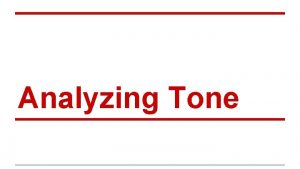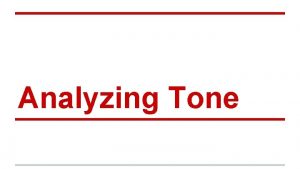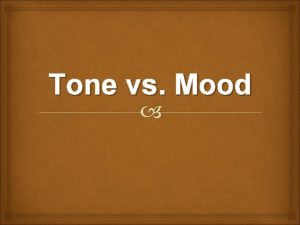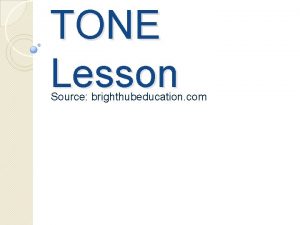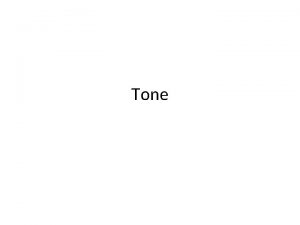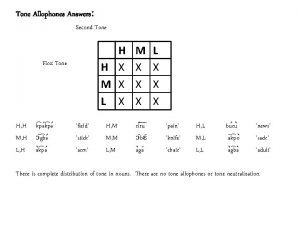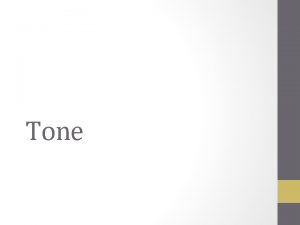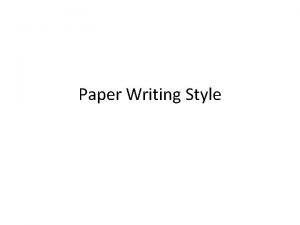Style Analysis A path for identifying tone TONE
























- Slides: 24

Style Analysis A path for identifying tone

TONE • Tone is defined as the author’s attitude toward his work or his audience. • Tone may also be a character’s attitude within a selection. • Each passage you read will have at least two different but complementary tones. • You will need to study lists of tone words to have a plethora of words to use in timed situations. One such list is being passed out, although many more exist!

TONE • Your primary objective in any style analysis is to show the author created the tones in the passage. Each of the following units will address a rhetorical device and its application to tone. • Remember: You will always find at least two tones!

INTEGRATING QUOTATIONS • When you analyze style, you will often need to quote from within the passage to illustrate. Practice EMBEDDING (or INCORPORATING, INTEGRATING) quotations so that they become a natural part of your own sentence.

INTEGRATING QUOTATIONS • Here is an example of a poorly integrated quotation: The phrase, “the gloom hovering over them, ” shows the ominous feeling of the scene. • This is better: The scene with “the gloom hovering over them” was an eerie and dismal picture.

INTEGRATING QUOTATIONS • If you change the form of a word, use brackets to show that you did so: As the “gloom [hovered] over them, ” the reader felt a sense of ominous unrest. • If you leave words out, use ellipses to show that you did so: When Mama stood “quivering and glaring…with tears streaming down her cheeks, ” the reader could clearly understand her pain and frustration.

DICTION, LANGUAGE, and FIGUARATIVE LANGUAGE • Diction is defined as the important and individual words the author uses. Language, while it is grouped here with diction, is actually the body of diction used. (In “Casey at the Bat”, for example, the author uses words about baseball. Individually, they are considered diction; collectively, they are the language of baseball jargon. ) • Diction involves the positive, negative, or neutral connotations the words have. In order to assess diction, we must know the difference between CONNOTATION and DENOTATION.

DICTION, LANGUAGE, and FIGUARATIVE LANGUAGE • The DENOTATION of a word is its dictionary definition while the CONNOTATION is the emotional baggage that comes along with the word. • Example: The word “plump” is a person who is overweight (by definition), but the feelings associated with the word define it as pleasantly fat. • Once you have identified an author’s diction, you must ANALYZE it. This means that you write commentary about the word and the effect the word had on you as a reader, or in the passage as a whole. Some synonyms for COMMENTARY are ANALYSIS, INTERPRETATION, and EXPLICATION.

DICTION, LANGUAGE, and FIGUARATIVE LANGUAGE • Read the following sentence: John surveyed the class, congratulating himself for snatching the highest grade on the test without studying at all, unlike the other dolts in the class. • Identify the diction you found in that sentence, and then consider possible tone words for the sentence. • Possible tones include haughty, arrogant, conceited.

DICTION, LANGUAGE, and FIGUARATIVE LANGUAGE • The next step is to write commentary for the diction you highlighted. • Surveying • Commentary #1: conveys the idea of someone looking around as if he were a king looking at lowly subjects • Commentary #2: the boy sees himself on a kind of Mt. Olympus, sitting with other gods and looking down on lesser mortals.

The next step it to write the introduction paragraph. In this introduction, you should identify the two different but complementary tones, and establish a theme statement. Here is an example: The author’s techniques used in “The Rattler” convey not only a feeling of sadness and remorse but also a sense of the man’s acceptance of the snake’s impending death. A human being has confronted nature, and in order for him to survive, the snake must be killed. The reader feels sympathy for the man’s plight and a reluctant agreement with him for his decision.

Continue Writing • Now it is time to write the second paragraph of the essay. In this paragraph, you will discuss one of the rhetorical devices found in the passage. This one will analyze only diction. This paragraph must begin with a topic sentence which uses the device which is to be studied. Here, that word is diction. Read the following example of a topic sentence on diction. The author’s diction heightens the power and force behind the snake as it responds to the man.

Continue Writing • The next part of the paragraph follows a specific pattern. You will write one example sentence with the diction examples you have chosen, then two sentences of commentary. The commentary must echo the tones established in the introduction. This unit of writing – one example and two commentaries is called a “chunk”. You will need at least two chunks in each body paragraph. • In the diction example sentences you will need at least three examples of diction from several parts of the passage. Read the example sentence below: Like a soldier, the snake lay “arrested, ” waiting for the “unprovoked attack” after shaking his “little tocsin” at the man.

Commentary • The next step is to write commentary (analysis or interpretation) for the three quotes you included in your example sentence. • Here is a sample of commentary from the previous example sentence: – Commentary #1: feeling of adversary vs. adversary – Commentary #2: snake knows its power but holds back; doesn’t want to fight but signals that it will defend itself if necessary • Commentary does not mean paraphrasing the quotation. It means thinking about the feeling behind the quotations and the reader’s response.

DICTION, LANGUAGE, and FIGUARATIVE LANGUAGE Read the following paragraph on diction in “The Rattler”: The author’s diction heightens the power and force behind the snake as it responds to the man. “Arrested” at first, the snake becomes a “live wire” as he shakes his “little tocsin” at the man. Unmoving at first, the snake plays a waiting game as adversary meets adversary across an imaginary line drawn in the desert. Then a feeling of electricity jolts the reader, heart beating faster from the noise of the warning that, like battle stations aboard a ship, calls all to readiness. Yet it must lose; despite its attempts to hide in the “paper-bag bush, ” the snake knows its life has been “dearly sold, ” but it remains “sinuous and self-respecting” in the man’s mind. The hiding place is an illusion, and a costly one. The reader admires the valiant behavior of the snake’s last moments and the dignity which the man offers. All involved recognize the strength of the man and the almost-human snake but know that responsibility and duty to others make the killing necessary.

IMAGERY • Imagery is defined as concrete or specific information that can be perceived through the five senses. • Imagery is used to describe concrete words and phrases. Imagery contrasts with diction in that Imagery does not by itself have connotation while diction is purely emotional.

IMAGERY • The steps for completing this paragraph are very much like the diction paragraph. If this were an actual paper, you would not need to write another introduction. The first one will do. • You would, however, need to write the next body paragraph. This one is about imagery, so your topic sentence should reflect that change: The author’s use of imagery supplies the reader with a well-defined picture of the actions of both the snake and the man.

IMAGERY • Just as with diction, the next part of the essay is an example sentence. This time, because of the length of the examples, you will need to incorporate only TWO. For example: The snake “shot into a dense bush…rattling, ” leaving the man no choice but to wield the hoe “hacking about, soon [dragging] him out…his back broken. ” • The next step involves writing commentary. These commentary are about the example above: – Commentary #1: once the snake feels threatened, it takes cover and gives warning – Commentary #2: the man now feeling threatened in return makes the choice to deliver the fatal blows

IMAGERY Read the following paragraph on imagery in “The Rattler”: The author’s use of imagery supplies the reader with a welldefined picture of the actions of both the snake and the man. The snake “shot into a dense bush…rattling, ” leaving the man no choice but to wield the hoe “hacking about, soon [dragging] him out…his back broken. ” Once the snake feels threatened, it takes cover in the paper-bag bush and warns the man of impending danger. However, now that he is being threatened himself, the man must take action and deliver the fatal blows. After the man has killed the reptile, the “jaws gape and snap, ” as the snake’s “poison [drips] from his fangs. ” Even after the snake is dead, the reader clearly understand the danger the man and everyone at the ranch would have been in had the snake been permitted to go free. Therefore, the difficult decision to kill the snake was the necessary one. We commiserate with the man as he performs his distasteful and necessary task.

SYNTAX, SENTENCE STRUCTURE, PHRASING • Syntax refers to the way words and phrases are arranged to form phrases and sentences. Like organization, identifying syntax can be difficult to do. Here is a list of items you might look for when analyzing for syntax: – – – specific patterns of phrases and sentences divisions within a piece with different syntax for each parallel structure different sentence types specific kinds of punctuation • Of course, this list is only a partial one. There are many other patterns you might look for.

SYNTAX, SENTENCE STRUCTURE, PHRASING • When you are analyzing syntax, follow these steps: – Number the sentences in the passage. This will aid your discussion of the syntax. – Mark observations about the syntax in the margins as you read.

SYNTAX, SENTENCE STRUCTURE, PHRASING • The next step is to write a topic sentence for the syntax paragraph. Here is a sample: The author’s syntax reflects the ominous confrontation between the man and the snake. • The second step is to write an example sentence. You may quote if you wish, but it is not required. Read the following example: The author chooses to end the first paragraph with a short sentence in contrast to the longer sentences that proceed it.

SYNTAX, SENTENCE STRUCTURE, PHRASING • Next, as usual, write commentary, observations about the author’s syntax. Ask yourself two questions: – Why did the author use this syntax? – What effect does it have on the reader or the tone? • The following examples are commentary for the previous example sentence – Shorter sentence mirrors the abruptness with which the man comes to a halt – Author is using syntax to support meaning and feeling of the piece

SYNTAX, SENTENCE STRUCTURE, PHRASING Read the following paragraph on syntax in “The Rattler”: The author’s syntax reflects the ominous confrontation between the man and the snake. For example, the author chooses to end the first paragraph with a short sentence in contrast to the longer sentences that proceed it. The shorter sentence mirrors the abruptness with which the man comes to a halt. The author, therefore, is using syntax to support the meaning and feeling of the piece. Later in the selection, the author uses a dash to separate “proving that a dead snake may still bite” from the rest of the sentence. This punctuation draws the reader’s attention to the danger that the snake imposed. Obviously this information is what the author wants emphasized. The author’s choice of syntax allows the reader to understand that the man sincerely had no choice but to kill the snake.
 Style and tone examples
Style and tone examples Tone and style
Tone and style Identifying tone and style
Identifying tone and style Style and tone examples
Style and tone examples Identifying and non identifying adjective clauses
Identifying and non identifying adjective clauses Whats an adjective clause
Whats an adjective clause Information essential
Information essential Author's tone and bias
Author's tone and bias Tone vs diction
Tone vs diction Unity signalr
Unity signalr Identifying actors and use cases using textual analysis
Identifying actors and use cases using textual analysis Block styles
Block styles Writing informal
Writing informal Formal vs. informal writing
Formal vs. informal writing Nnn speech
Nnn speech Puritan poetry
Puritan poetry Periodic style vs running style
Periodic style vs running style Iso 22301 utbildning
Iso 22301 utbildning Typiska novell drag
Typiska novell drag Tack för att ni lyssnade bild
Tack för att ni lyssnade bild Vad står k.r.å.k.a.n för
Vad står k.r.å.k.a.n för Varför kallas perioden 1918-1939 för mellankrigstiden?
Varför kallas perioden 1918-1939 för mellankrigstiden? En lathund för arbete med kontinuitetshantering
En lathund för arbete med kontinuitetshantering Personalliggare bygg undantag
Personalliggare bygg undantag Tidbok yrkesförare
Tidbok yrkesförare
